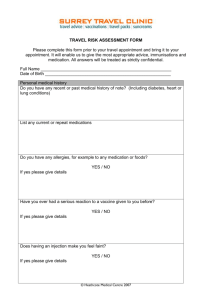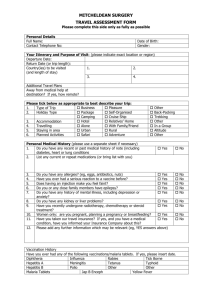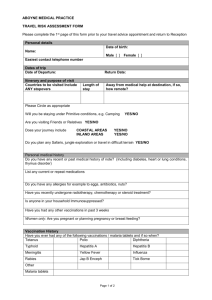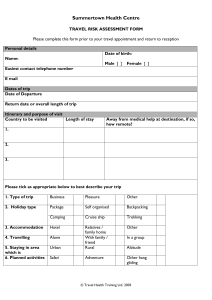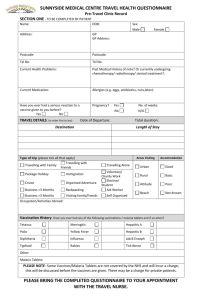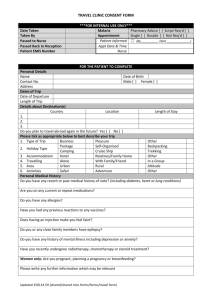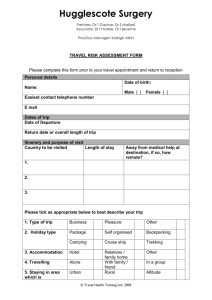Cover pagePREVALENCE OF ACUTE HEPATITIS A VIRUS AND CO INFECTION WITH MALARIA PARASITE AMONG PATIENTS ATTENDING THE DEPARTMENT OF HEALTH SERVICE UNIVERSITY OF BENIN, BENIN CITY, EDO STATE.
advertisement
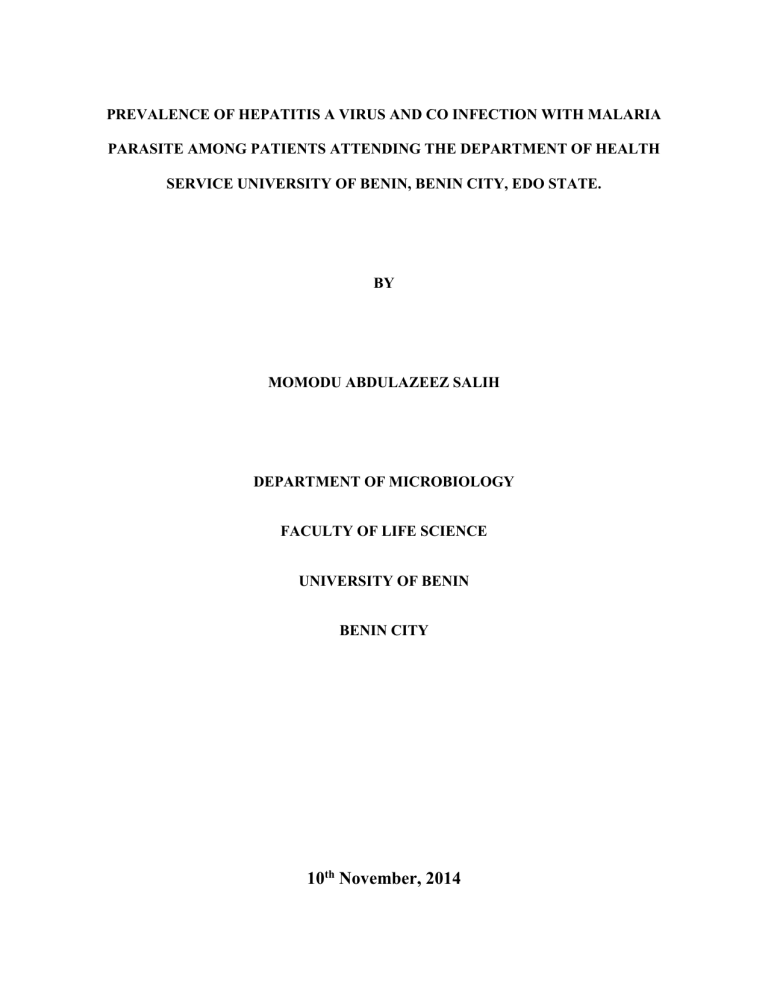
PREVALENCE OF HEPATITIS A VIRUS AND CO INFECTION WITH MALARIA PARASITE AMONG PATIENTS ATTENDING THE DEPARTMENT OF HEALTH SERVICE UNIVERSITY OF BENIN, BENIN CITY, EDO STATE. BY MOMODU ABDULAZEEZ SALIH DEPARTMENT OF MICROBIOLOGY FACULTY OF LIFE SCIENCE UNIVERSITY OF BENIN BENIN CITY 10th November, 2014 CERTIFICATION This is to certify that I, Momodu Abdulazeez Salih with matriculation number LSC1005455 carried out this project work in the Department of Microbiology, Faculty of Life Science, University of Benin, Benin City. ……………………. Prof. F.O. Ekhaise …………………. Date Head of Department …………………….. Miss. J.Z. Gwafan Supervisor ………………….. Date DEDICATION This work is dedicated to the almighty God the uncreated creator of the universe to whom I owe my existence and then to my parent, friends and well-wishers. ACKNOWLEDGEMENT I use this opportunity to thank God Almighty to whom I own my being, and for giving me the strength to carry out this work. Also to my supervisor Miss. J.Z. Gwafan, for her guidance and contribution throughout the course of this work. I also appreciate the entire lecturers and staff of the Department Of Microbiology especially the Head of Department prof. F.O. Ekhaise for their support so far. Also I thank my parent for their support and encouragement Finally this aspect will not be complete without appreciating my friend and course mate for their help and contribution. God bless you all. ABSTRACT TABLE OF CONTENT TITLE PAGE…………………………………………………………… CERTIFICATION………………………………………………………. DEDICATION……………………………………………………………. ACKNOWLEDGEMENT…………………………………………………. ABSTRACT……………………………………………………………….. TABLE OF CONTENT……………………………………………………. CHAPTER ONE…………………………………………………………… 1.0 Introduction……………………………………………………………… 1.1 Background………………………………………………………………… 1.2 Statement of problem………………………………………………………….. 1.3 Justification……………………………………………………………………… 1.4 Aim of study……………………………………………………………… CHAPTER TWO…………………………………………………………… 2.0 Literature review…………………………………………………………… 2.1 Properties of Hepatitis A virus…………………………………………… 2.1.1 Mode transmission……………………………………………………. 2.1.2 Distribution/occurrence………………………………………………… 2.1.3 Clinical manifestation………………………………………………… 2.1.4 Diagnosis……………………………………………………………… 2.1.5 Treatment……………………………………………………………… 2.1.6 Prevention……………………………………………………………… 2.2.0 Plasmodium species………………………………………………… 2.2.1 Brief history…………………………………………………………… 2.2.2 Life cycle……………………………………………………………… 2.2.3 Epidemiology………………………………………………………… 2.2.4 Transmission……………………………………………………… 2.2.5 Pathology/clinical symptoms………………………………………… 2.2.6 Diagnosis……………………………………………………………… 2.2.7 Treatment…………………………………………………………… 2.2.8 Prevention and control………………………………………………… 2.3 Co-infection of Hepatitis A virus with malaria parasite……………… CHAPTER THREE……………………………………………………… 3.0 Materials and methods……………………………………………… 3.1 Study area …………………………………………………………… 3.2 Study design…………………………………………………………. 3.3 Sample size 3.3 determination………………………………………. 3.4 Study population……………………………………………………… 3.5 Inclusion and exclusion criteria……………………………………… 3.6 Data collection ……………………………………………………… 3.7 Sample collection……………………………………………………… 3.8 Serological examination of HAsAg…………………………………… 3.8.1Principle of examination……………………………………………… 3.8.2 Assay procedure……………………………………………………… 3.9 Malaria parasite test…………………………………………………… 3.9.1Test procedure……………………………………………………… 3.10 Data analysis…………………………………………………………… CHAPTER FOUR…………………………………………………………… Data presentation……………………………………………………………. CHAPTER FIVE……………………………………………………………. 5.0 Discussion ……………………………………………………………… 5.1 Conclusion……………………………………………………………….. 5.2 Recommendation………………………………………………………… REFERENCE…………………………………………………………………. APPENDIX…………………………………………………………………… CHAPTER ONE 1.0 INTRODUCTION 1.1 BACKGROUND The name hepatitis is derived from the Greek word: hepar meaning liver and itis, meaning "inflammation" (Ifeanyi et al., 2014). It was formerly called Infectious hepatitis, Epidemic hepatitis, Epidemic jaundice, Catarrhal jaundice, Type A hepatitis, (HA). Hepatitis is defined broadly as liver parenchymal inflammation. (Ronald et al., 2000). Infection with hepatitis A leads to symptoms that are very similar to other types of hepatitis but unlike hepatitis B and C, hepatitis A is rarely fatal and does not lead to chronic liver disease. Nonetheless, hepatitis A is a significant cause of illness and suffering in many parts of the world (Lori, 2001). Hepatitis A virus (HAV) is a member Picornovirus family. Hepatitis A virus is a 27-32 nm spherical particle with cubic symmetry, containing a single-stranded RNA genome with a size of 7.5 kb. (Geo et al., 2010). It causes an acute selflimited illness characterized by jaundice, fever, anorexia, and diarrhea. The virus is transmitted almost exclusively through the fecal-oral route (Ronald et al. 2000). The two distinct forms of the virus were only identified in 1973, consisting of a RNA virus with four genotypes (Gairy et al., 2007). It occurs worldwide but is highly prevalent in the developing countries; however, the global incidence is decreasing because of improved sanitary and living conditions. (Gairy, 2007). Hepatitis A virus (HAV) infection is an acute, usually a self-limiting illness (Mariska et al., 2014). Its manifestations vary according to the age of the patient at presentation. Children usually have a silent or subclinical course as opposed to adults, who present with a wide range of symptoms, from an influenza-like illness to fulminant hepatic failure (Gairy, 2007). Acute infection is confirmed by detection of IgM anti–hepatitis A virus, which appears early in the course of infection while transaminase levels are still elevated and viral shedding is still occurring. Rheumatoid factor potentially can cause falsepositive results (Ronald et al., 2000). Immunoglobulin G anti-HAV becomes the predominant antibody during convalescence and persists throughout life; measurement of IgG anti-HAV serves little clinical purpose other than to confirm previous infection. Since HAV is usually a self-limiting disease, treatment is generally supportive. Eighty-five percent of patients recover by three months, and nearly 100% will recover by six months. Death can occur in elderly patients or in those concomitantly infected with hepatitis C virus (HCV) (Ronald et al., 2000). Malaria is one of the world’s deadliest diseases affecting people particularly in tropical and sub-tropical regions of the world (Ekwunife et al., 2011). Malaria remains the most complex and overwhelming health problem facing humanity (ref), with 300 to 500 million cases and 2 to 3 million deaths per year (WHO, 2003). Malaria is the major cause of morbidity and mortality in Nigeria, and particularly affects children under five years of age (Federal Ministry of Health, 2001). Four species of plasmodium cause malaria in human : Plasmodium vivax, P. falciparum, P. malariae and P ovale. The two most common species are P. vivax and P. falciparum, with P. falciparum being the most pathogenic of all (Geo et al., 2010). Transmission to human is by blood sucking bite of female Anopheles mosquitos (Geo et al., 2010). The incubation period for malaria is usually between 9 and 30 days, depending on the infecting species. For P vivax and P falciparum, this period is usually 10-15 days, but it may be weeks or months (Geo et al., 2010). Falciparum malaria, which can be fatal, must be suspected if fever, with or without other symptoms (like nausea, vomiting, and headache), develops at any time between one week after the first possible exposure to malaria and 2 months or even longer after the last possible exposure (Geo et al., 2010). Hepatitis and malaria are highly endemic in most parts of Nigeria (Ifeanyi et al., 2013). Both hepatitis and malaria can co - exist in one patient and often times, one may be confused with or misdiagnosed for the other. Their causes, prognosis and management of hepatitis and malaria are quite different from each other. In Nigeria, malaria is more commonly reported and appears to be more prevalent than hepatitis (Ifeanyi et al., 2013). Hepatitis and malaria are associated with a number of complications which pose major challenges to human health especially pregnant women and children. In the recent time, the resurgence of malaria is threatening many countries in different regions of the world. George and Nmoka (2003) reported that malaria causes severe anaemia and opined that this could be related to lipid hydro peroxidation. The public health implications and challenges of hepatitis and malaria have been reported by previous workers. Complicated malaria has been associated with different organ involvement such as the brain, liver and placental transmission to unborn babies (Ifeanyi et al., 2013). In the recent time, the resurgence of malaria is threatening many countries in different regions of the world. Complicated malaria has been associated with different organ involvement such as the brain, liver and placental transmission to unborn babies (Ifeanyi et al., 2013). 1.2 Statement 0f Problem Infections involving both of malaria and hepatitis remain serious health issues in developing countries. Malaria is one of the world’s deadliest diseases affecting people particularly in tropical and sub-tropical regions of the world ((Ekwunife et al., 2011).). Malaria remains the most complex and overwhelming health problem facing humanity, with 300 to 500 million cases and 2 to 3 million deaths per year. About 90% of all malaria infections in the world today occur in Africa South of the Sahara. Majority of infections in the region are caused by Plasmodium falciparum, the most dangerous and the most effective malaria vector of the four human malaria parasites (WHO, 2003). The disease poses serious effect on the blood, destroying red blood cells and interfering with the haemoglobin, disrupting the red blood cells pigment and converting haemoglobin to methaemoglobin leading to methaemoglobinaemia (Isah et al., 2013). Hepatitis A virus infection on the other hand is usually an acute self-limiting disease with no sequelae or chronic disease state. Its manifestations vary according to the age of the patient at presentation. Children usually have a silent or subclinical course as opposed to adults, who present with a wide range of symptoms, from an influenza-like illness to fulminant hepatic failure (Gairy et al., 2007). Once infected with hepatitis A virus, a person is immune from further infection with hepatitis A for life. There is still a risk, however, from other types of hepatitis (Geo et al., 2010). The relationship between age at infection and the clinical disease should be clearly understood. In pre-school children (less than 6 years) most infectious are either asymptomatic or with mild and/or non-specific symptoms. The jaundice occurs in less than 10% of younger children (less than 6 years), 40%-50% of older children (6-14 years), and 70%-80% of adults. The pattern of age at infection and clinical disease may change in some countries due to rapid socioeconomic development (Ali et al., 2007). Hepatitis and malaria are highly endemic in most parts of Nigeria (Ifeanyi et al., 2013). Both hepatitis and malaria can co - exist in one patient and often times, one may be confused with or misdiagnosed for the other. Their causes, prognosis and management of hepatitis and malaria are quite different from each other. In Nigeria, malaria is more commonly reported and appears to be more prevalent than hepatitis. About 90% of the morbidity and mortality from malaria occur in tropical Africa (Federal Ministry of Health, 1991). The socio-economic consequences of hepatitis and malaria are high. World Health Organization (1999) reported that malaria costs African countries, south of the Sahara, more than US S2 billion in 1997, yet some of these countries are the most impoverished. Malaria bout can incapacitate a worker for 5 to 20 days and malaria – afflicted families on the average can only harvest 40% of the crops harvested by healthy families (Ifeanyi et al., 2013) 1.3 Justification Malaria is a major public health problem in Nigeria where it accounts for more cases and deaths than any other country in the world. Malaria is a risk for 97% of Nigeria’s population (United State Embassy, 2011). The remaining 3% of the population live in the malaria free highlands. There are an estimated 100 million malaria cases with over 300,000 deaths per year in Nigeria. Malaria contributes to an estimated 11% of maternal mortality (United State embassy in Nigeria, 2011). Hepatitis A on other hand, is one of the oldest diseases known to humankind, is a self-limited disease which results in fulminant hepatitis and death in only a small proportion of patients. However, it is a significant cause of and socio-economic losses in many parts of the world. World Health Organization (1999) reported that malaria costs African countries, south of the Sahara, more than US S2 billion in 1997, yet some of these countries are the most impoverished. Malaria bout can incapacitate a worker for 5 to 20 days and malaria – afflicted families on the average can only harvest 40% of the crops harvested by healthy families (Ifeanyi et al., 2013). People who have never contracted HAV and who are not vaccinated against hepatitis A, are at risk of infection. The risk factors for HAV infection are related to resistance of HAV to the environment, poor sanitation in large areas of the world, and abundant HAV shedding in faeces. In areas where HAV is highly endemic, most HAV infections occur during early childhood. Occasionally, HAV is also acquired through sexual contact (anal-oral) and blood transfusions (WHO/CDS, 2000). Ayoola., 1982 determined the prevalence of Hepatits A virus to be 82 in Nigeria. Since Nigeria is at high risk of co-infection of Hepatitis A virus infection and malaria, there is need to study their co-existence in the population 1.4 Aim and objective of Study General The aim of this research is to determine the prevalence of hepatitis A and co infection with malaria among the general population attending the Department of Health Service University of Benin, Benin city, Edo state. Specific 1. To determine the prevalence of hepatitis A virus among patients of different age group attending the Department of Health Service University of Benin. 2. To determine the co infection of hepatitis A virus with malaria parasites among the study population. 3. To access the risk factors associated with hepatitis A virus among the study population. CHAPTER TWO CHAPTER THREE 2.0 MATERIALS AND METHODS 2.1 Study Area The study will be conducted at the Department of Health Service University of Benin, Benin City, Edo state. 2.2 Study Design The study is a descriptive cross sectional and experimental study combining the use of administered structured questionnaire and analysis of serum sample taken from consented patients. 2.3 Sample Size Determination The sample size will be determined using the following equation as described by (Ifeanyi et al., 2014) n=z2p(1-p)/d2 Where n= sample size z= statistics for a level of 95% confidence interval =1.962 p= prevalence rate at 82% Imo Nigeria (Ayoola, 1982) d= precision (allowable error) = 5% = 0.05 Therefore n= (1.962)2 x 0.82 x (1-0.82) (0.05)2 =3.849 x 0.82 x (0.18) (0.05)2 = 0. 568 0025 =227.27 =227 samples 2.4 Study Population The target population comprised of the general population which include staff, staff dependent and student of university of Benin, attending the Department of Health Service University of Benin, Benin City, Edo state, Nigeria. 2.5 Inclusions and Exclusion criteria Inclusion criteria: The general population both males and females of various age group attending the Department of Health Service University of Benin that gives their consent. All patients will be counseled and recruited and those that give their consent will be enrolled. Exclusion criteria: the general population who refused to give consent as well as people not attending the Department of Health Service University of Benin. 2.6 Data Collection Prior to collection a structured questionnaire will be administered to the target population to obtain risk factor associated with hepatitis A virus 2.7 Sample Collection Blood samples will be collected with the assistance of a laboratory scientist from patients who give their consent. All materials required for collection of blood samples will be assembled and labeled with patient’s (subject) identification (ID) and date. 5ml of blood will be collected using syringe and needle into anticoagulant bottles, immediately the blood samples will be used to prepare blood films on clean grease free slide for malaria parasite test. The blood in the anticoagulant bottles will be centrifuged at 1000rpm for 10min. the plasma will be collected into a clean container and will be stored by refreeze at -20C till when needed for HAV test. 2.8 Serological Examination of HAsAg Hepatitis A surface antigen will be detected using in vitro diagnostic kit following the manufacturer’s procedure. 2.8.1 Principle of Examination The membrane is pre-coated with anti-HAsAg on the test line region of the test. During testing, the serum or plasma specimen reacts with the particle coated with anti-HAsAg antibody. The mixture migrates upward on the membrane chromatographically by capillary action to react with anti-HAsAg antibodies on the membrane and generate a colored line. The presence of this colored line in the test region indicates a positive result, while its absence indicates a negative result. To serve as a procedural control, a colored line will always appear in the control line region indicating that proper volume of specimen has been added and membrane wicking has occurred 2.8.2 Assay Procedure All test device, plasma specimen will be equilibrated to room temperature (1530°C) prior to testing. Pouch will be brought to room temperature before opening it. The test device (HAsAg strip) will be placed on a clean and level surface and 60μl of plasma will be added to the well of the test device and then the timer will run for 15minutes. Results will be read after 15minutes, positive results will show two distinct red lines and negative results will show one red line. 2.9 Malaria parasite test Malaria parasite will be detected or diagnosed using microscopy. 2.9.1 Test procedure The blood samples in anticoagulant bottles were used to prepare duplicates of thin and thick blood films on clean grease – free slides. The thick films after drying were stained with Giemsa stain and left for 10 min. All the stained films were properly labeled with the patients’ index number and allowed to dry. The stained thick and thin blood films were examined microscopically for malaria parasites using oil immersion objectives. If no parasite is seen the sample will be designated ‘negative’, or more accurately, ‘no malaria parasites seen’. Positive findings were graded on the thick smear using the ‘plus’ system scale: + (1 to 9 trophozoites in 100 fields); ++ (1 to 10 trophozoites in 10 fields); +++ (1 to 10 trophozoites per field); ++++ (>10 trophozoites per field). 2.10. Data Analysis Results from test analysis and data from questionnaires will be reduced to percentages and presented on tables and graphs.

